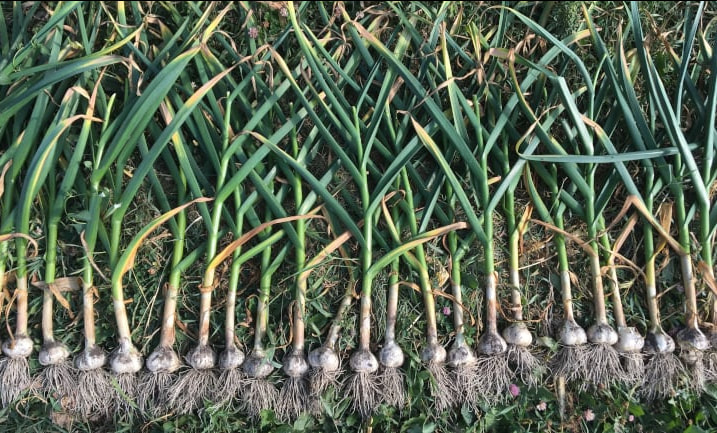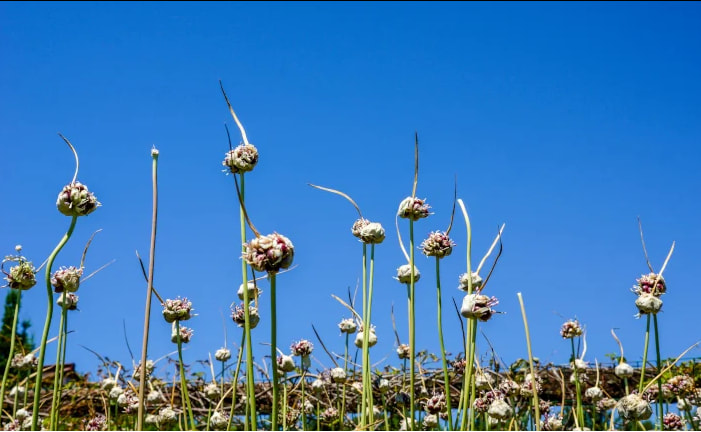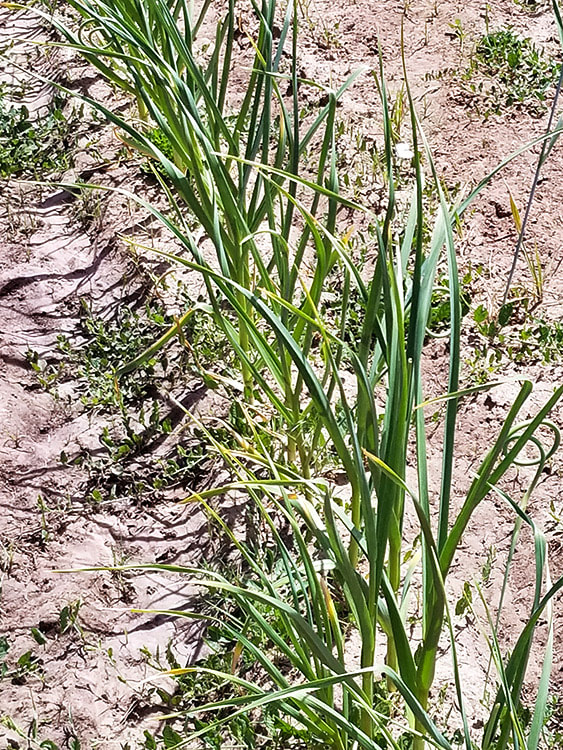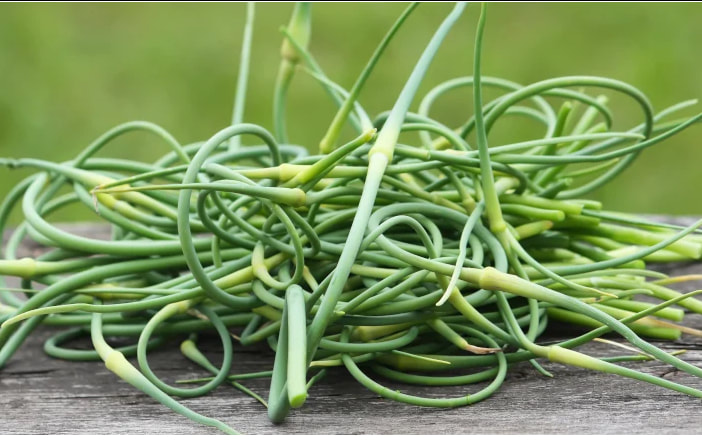|
By Jessica Rath Did you know that there are hundreds of different varieties of garlic? I didn’t, and I had no idea that there are two subspecies of Allium sativum, the relative of onions, leeks, chives etc., distinctive because of its pungent odor and taste. It took a visit with La Madera garlic farmer Bill Page and his wife Claudia to divest me of my ignorance. And as it so often happens with these interviews, it was a delight to meet my hosts and experience where they live. The scenery around La Madera is absolutely stunning. Bill grew up in Denver, Colorado, together with his younger sister and brother. They were raised mainly by his mother, an unconventional and sophisticated individual who took her children to Europe for several years, so they could be exposed to different cultures and learn foreign languages. After more than two years at Swiss boarding schools where he learnt fluent French, Bill returned temporarily to the U.S. and got a Bachelor’s degree from Claremont McKenna College in California. He got married and went back to Europe for a year, but it ended in divorce in the late 70s, after 16 years. In October 1985, Bill married again, and when Claudia, his current wife, closed up her business in 1994, they moved from Denver to La Madera. They bought into a family compound of 30 riverfront acres with a brother of Claudia’s, Nick, her sister Leza, and Leza’s husband Daryl. In March 1995 they had finished building their house and moved in. Do you remember the showing of the documentary Navalny in El Rito, a while ago? Part of the work actually happened at Claudia and Bill’s house. The film’s editor, Langdon Page who secured an Oscar for his team, is Bill’s son. His other son, David, is Executive Director of the non-profit national advocacy organization Winter Wildlands Alliance. Right from Day One Claudia and Bill got involved with the Acequia Association. There was an irrigation ditch, but it was dry. They had to resurrect the ditch, and with the help of a neighbor they got the water flowing again. “At various times I've been the Secretary, Treasurer, or the Mayordomo, or the President, or whatever, on and off for all those 30 years, and so has Claudia, and so has Daryl”, Bill told me. “People at the bottom of the ditch have to take more responsibility than the people at the top of the ditch if they want the water. That means, if nobody wants to be President or Secretary or Treasurer, or whatever, we are the ones that have to do it”. I was curious – how does one become a garlic farmer, I wondered. “Well, after my father saw this place, he said, ‘Bill, I think you ought to grow garlic’. I had no experience with garlic, but I was inclined towards agriculture, so I thought – , why not give it a try? I bought 20 different kinds of seed garlic and tried them out in little patches until I narrowed them down to three varieties which were doing well in this area. The three I ended up with all grow nice, big bulbs and they are all pungent and spicy. The Hispanic community loves to use them in their salsas. As soon as I started growing them out, I got carried away, and at one point, we had over 10,000 head in single planting”. Twenty different kinds? I thought there was only garlic. One kind. All the same. Bill had a lot of explaining to do. “No, there are a lot of different kinds of garlic. Add the fact that people like big bulbs, so they buy something that's not even garlic. They buy elephant garlic, which is technically a leek. But all the rest of the garlic is divided into softneck garlic and hardneck garlic. They're two separate genetic strains of garlic. I eliminated the soft necks, because their main advantage is for people who want to make garlic braids, because their necks are soft”. “I have three varieties. One is called Red Rezan, another one is Romanian Red, and then there is a German Brown”, Bill continued. “But there are hundreds of different varieties with lots of different tastes; some are mild, some are bland, some are big, some are small”. Hardneck garlic works well for smaller restaurants, Bill explained. They’re much easier to peel and each head has only three to six bigger cloves, compared to a head of softneck which can have up to 20 cloves. “When you want to sell garlic to restaurants, it's very nice to offer them hardneck garlic, like the kind that I grow”. Bill’s mentor was Stanley Crawford, the well-known garlic farmer and author who lived in Dixon. He died last year, which was a great loss to the garlic community, Bill said. But there was a big difference between the two: Stanley didn’t grow garlic for its culinary value but used it as a decorative item. “He would harvest lots of softneck garlic and hire people from Dixon or Embudo to help him dry it and braid it, and then he would put a ceramic medallion on each braid. He could get way more money for his garlic than I could, selling them at the Santa Fe Farmers Market, because people like the chile ristras, and they like to hang a garlic braid next to their ristras. He was able to sell them for what amounted to at least $5 a head. But I wanted to grow garlic that was culinarily interesting”. And then Bill told me about the legal battle which took Stanley Crawford to China, New York, and Washington. Most of the garlic sold in this country, about 85% of it, comes from China. As long as the buyer knows this and can decide which one to buy, that’s fine. But Stanley found out that some of the garlic which is sold by Christopher Ranch, a garlic supplier from Gilroy, California (known as the Garlic Capital of the World) originates from China but is sold under the Christopher Ranch label. “So Gilroy gets to import Chinese garlic under the Christopher Ranch name, and they never pay tariffs. Nobody can investigate them for dumping garlic when China has too big a harvest and they're drowning in garlic. They can sell it for 10 cents a head here, and make a lot of money”, Bill told me. I was shocked to learn this, of course. There is also a Netflix documentary, Garlic Breath – Episode Three of the Series Rotten, which shows how Chinese laborers work under deplorable conditions, that the Chinese companies manage to avoid paying import tariffs, and that the cheap garlic then is sold under the California company’s label. Christopher Ranch, of course, denies everything. I tried to find out whether this legal dispute has been resolved, without success. “These days I grow the same three varieties, but I only plant 700 cloves”, Bill continued. “Last year, it might have been 800 or 1000, but basically, I have no energy left for sitting at a Farmers Market selling garlic. I could probably sell it in bulk, but I don't have the people to do the harvesting. It takes quite a few people to harvest and hand-cure it so that it lasts a long time”. “Currently I grow just for friends and family, to give away, and to keep my strains. I tell people, I would rather have them buy for planting than for eating. I'll go ahead and give you ten heads if you promise me to plant six of them and just eat four. The problem always is that people buy ten heads and they end up eating it! Which is too bad, because everybody ought to be growing good garlic. It's easy to grow, one of the simplest crops there is, really. You plant it in October and you harvest it in July. It doesn't take much water. You water it once when you plant it, and you don't have to water it all winter, and you start again watering it in the spring”. We went outside and Bill showed me his garlic field. I noticed all these curly things – what are those? “That's what we call the scapes. They’re part of the hardneck garlic. You want to pick these when they're young and small, and you can just chop them up and mix them with vegetables and eggs and salads. It's pungent and spicy. The plant gets more energy into the bulb and will be bigger if you cut this off”. Are you growing any other crops, I asked Bill. “I’ve always grown a lot of rye, and quite a bit of wheat. And I grow vetch because it puts nitrogen back into the soil and reproduces lightly. We're getting into what's called no till planting, where you don't worry too much about weeds or anything else. You just plant right into a pasture or a meadow every year, and then arrange to harvest it. It's a sloppy, messy way of planting, but it's much better for the soil”. “There's a big machine that you can borrow from the Farm Service Agency or from what's called the East Rio Arriba Soil and Water Conservation District, a big machine that is called a No-till Seeder. So it's built to plant your seeds, vetch or carrots, anything you want. It's got about ten to fifteen seed compartments, one right beside another, and the seed goes down through the cutter knives and gets planted. And you can vary the depth of each seed”. That sounds very impressive, so much easier for the farmer! “It took a day and a half to plant all of our land. The whole place is 30 acres, but the plantable area is about ten and a half acres. And with the no-till planter I could plant it all in a day and a half”. Without this machine it must have taken two or three times as long, I bet… “We also grow other vegetables, because Claudia has wanted to. This year, she planted some potatoes. And she planted some beans. Your biggest problem is that elk or deer come to your garden and eat it all! Claudia planted a row of beans, 300 feet long on some of these terraces, and it takes a small herd of deer or small herd of elk two or three nights to eat them after they get to a certain size. And then it's all dead. It's very discouraging”. There’s no way to keep them out, but at least they can’t get at the potatoes. What a lovely and informative afternoon this was. My embarrassing ignorance about garlic has finally been fixed. It is such an essential ingredient of cooking all over the world that it deserves more attention than I gave it. Thank you, Bill, for taking the time to show me around.
And if you want to grow your own garlic – I’m sure Bill will help you. I went home with a head which I will plant this coming October.
1 Comment
Barbara Campbell
9/27/2024 11:11:41 am
I would love to have some of your garlic to grow and now seems to be a good time to get started. How would I make this happen?
Reply
Your comment will be posted after it is approved.
Leave a Reply. |
Submit your ideas for local feature articles
Profiles Gardening Recipes Observations Birding Essays Hiking AuthorsYou! Archives
October 2025
Categories
All
|









 RSS Feed
RSS Feed